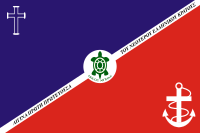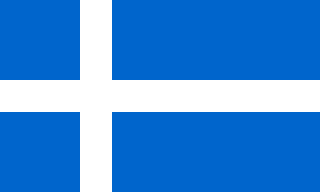This article relies largely or entirely on a single source .(March 2018) |
 | |
| Use | FIAV |
|---|---|
| Proportion | 2:3 |
The Flag of Aegina is the flag used in Aegina island in Greece.
This article relies largely or entirely on a single source .(March 2018) |
 | |
| Use | FIAV |
|---|---|
| Proportion | 2:3 |
The Flag of Aegina is the flag used in Aegina island in Greece.
The flag of Aegina is diagonally divided by a white stripe, with the upper part blue with a blue cross outlined in white and the lower part red with a white fouled anchor. In the middle of the flag, a white disc is charged with a green turtle, the island's symbol in ancient Greece. Under the turtle is written ΝΗΣΟΣ ΑΙΓΙΝΑ (Nisos Aigina, Aegina Island) and the diagonal inscription says: ΑΙΓΙΝΑ: ΠΡΩΤΗ ΠΡΩΤΕΥΟΥΣΑ ΤΟΥ ΝΕΟΤΕΡΟΥ ΕΛΛΗΝΙΚΟΥ ΚΡΑΤΟΥΣ ("Aegina: First capital of the new Greek state"). The town of Aegina was indeed the first capital of Greece after the independence, even for about a month. The government then moved to Nafplio and finally to Athens. [1]


Aeacus was a mythological king of the island of Aegina in the Saronic Gulf.

Aegina is one of the Saronic Islands of Greece in the Saronic Gulf, 27 km (17 mi) from Piraeus. Tradition derives the name from Aegina, the mother of the hero Aeacus, who was born on the island and became its king.

The current flag of Alabama was adopted by Act 383 of the Alabama state legislature on February 16, 1895:
The flag of the State of Alabama shall be a crimson cross of St. Andrew on a field of white. The bars forming the cross shall be not less than six inches broad, and must extend diagonally across the flag from side to side." – (Code 1896, §3751; Code 1907, §2058; Code 1923, §2995; Code 1940, T. 55, §5.)

The Saronic Gulf or Gulf of Aegina in Greece is formed between the peninsulas of Attica and Argolis and forms part of the Aegean Sea. It defines the eastern side of the isthmus of Corinth, being the eastern terminus of the Corinth Canal, which cuts across the isthmus. The Saronic Islands in the gulf have played a pivotal role in the history of Greece, with the largest, Salamis, naming a significant naval battle in the Greco-Persian wars. The Megara Gulf makes up the northern end of the Saronic Gulf.

The flags of the Confederate States of America have a history of three successive designs from 1861 to 1865. The flags were known as the "Stars and Bars", used from 1861 to 1863, the "Stainless Banner", used from 1863 to 1865, and the "Blood-Stained Banner", used in 1865 shortly before the Confederacy's dissolution. A rejected national flag design was also used as a battle flag by the Confederate Army and featured in the "Stainless Banner" and "Blood-Stained Banner" designs. Although this design was never a national flag, it is the most commonly recognized symbol of the Confederacy.

A saltire, also called Saint Andrew's Cross or the crux decussata, is a heraldic symbol in the form of a diagonal cross, like the shape of the letter X in Roman type. The word comes from the Middle French sautoir, Medieval Latin saltatoria ("stirrup").

The national flag of Greece, popularly referred to as the "blue and white" or the "sky blue and white", is officially recognised by Greece as one of its national symbols and has nine equal horizontal stripes of blue alternating with white. There is a blue canton in the upper hoist-side corner bearing a white cross; the cross symbolises Eastern Orthodox Christianity, the prevailing religion of Greece. The blazon of the flag is Azure, four bars Argent; on a canton of the field a Greek cross throughout of the second. The official flag ratio is 2:3. The shade of blue used in the flag has varied throughout its history, from light blue to dark blue, the latter being increasingly used since the late 1960s. It was officially adopted by the First National Assembly at Epidaurus on 13 January 1822.

The flag of Bosnia and Herzegovina contains a wide medium blue vertical band on the fly side with a yellow right triangle abutting the band and the top of the flag. The remainder of the flag is medium blue with seven full five-pointed white stars and two half stars top and bottom along the hypotenuse of the triangle.

The flag of the Marshall Islands, an island nation in the Pacific, was adopted upon the start of self-government, May 1, 1979. The flag was designed by Emlain Kabua, who served as the first First Lady of the republic.

The flag of Solomon Islands consists of a thin yellow diagonal stripe divided diagonally from the lower hoist-side corner, with a blue upper triangle and green lower triangle, and the canton charged with five white stars. Adopted in 1977 to replace the British Blue Ensign defaced with the arms of the protectorate, it has been the flag of Solomon Islands since 18 November of that year, eight months before the country gained independence. Although the number of provinces has since increased, the number of stars on the flag that originally represented them remained unchanged.

The flag of the Cayman Islands consists of a Blue Ensign defaced with the British overseas territory's coat of arms. Adopted in 1959 to supplement the Union Jack and to replace the flag of the Colony of Jamaica, it has been the flag of the Cayman Islands since the territory was granted self-government that year. The design of the present flag entailed removing the white disc and outlining the coat of arms with a white trim, although the previous version is often used in an official capacity. The Cayman Islands' flag is similar to the flags of eight other British Overseas Territories, which are also Blue Ensigns with their respective coats of arms.

The Saronic Islands or Argo-Saronic Islands is an archipelago in Greece, named after the Saronic Gulf in which they are located, just off the Greek mainland. The main inhabited islands of this group are Salamis, Aegina, Agistri, and Poros. The islands of Hydra and Dokos, which lie off the northeast tip of the Peloponnese, are sometimes included as part of the Saronic Islands.

Aegina was a figure of Greek mythology, the nymph of the island that bears her name, Aegina, lying in the Saronic Gulf between Attica and the Peloponnesos. The archaic Temple of Aphaea, the "Invisible Goddess", on the island was later subsumed by the cult of Athena. Aphaia (Ἀφαῖα) may be read as an attribute of Aegina that provides an epithet, or as a doublet of the goddess.

True South is the only flag of Antarctica formally recognized by members of the Antarctic Treaty System, the condominium that governs the continent. However, adoption of the flag is not yet universal, and dozens of unofficial designs have also been proposed.

The flag of Shetland is a white or silver Nordic cross on a blue background. The flag uses the colours of the flag of Scotland, but in the form of the Nordic cross in order to symbolise Shetland's historical and cultural ties with Scandinavia. As with all Scottish flags, its proportions and colour shades are not fixed. It was created by Roy Grønneberg and Bill Adams in 1969, to commemorate the 500th anniversary of the transfer of the islands from Norway in the Kalmar Union to Scotland and the 500 years before as part of Norway.

Piraeus Prefecture was one of the prefectures of Greece. Created in 1964 as a separate Prefecture (Νομός) and after the dissolution of the prefecture in 1972 was one of the 4 prefectures (Νομαρχίες) of Attica prefecture, and from 1994, part of the Athens-Piraeus super-prefecture (1994–2011). The capital of the prefecture was Piraeus. As a part of the 2011 Kallikratis government reform, the prefecture was abolished, and its territory was divided into two regional units: Islands and Piraeus.

The Coinage of Aegina began in the 6th century BC. The front has a sea turtle design, while the back has a punch mark, found on most coins at that time. The earliest coins were made of electrum, a mix of gold and silver. The coins were first made in the island of Aegina, off the southeast side of Greece. Some historical sources say the first coins were made by the king of Argos, Pheidon. The coins with 'turtle' design are considered "an important early trading currency".

Kastellorizo is the easternmost Greek island and is situated in the Eastern Mediterranean. It lies about 2 miles (3 km) from the Anatolian coast (Lycia), more or less halfway between Rhodes and Antalya.

Agistri, also Angistri or Agkistri, is a small island and municipality in the Saronic Gulf in the Islands regional unit, Greece.

The national colours of Greece are blue and white.